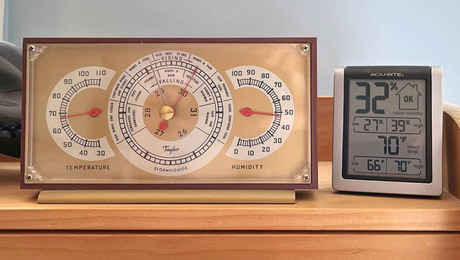I have 2 existing bathroom exhaust fans for which I need to replace the ducting. The two merge at a Y and then go straight up through the roof. I bought 4″ insulated flex ducting, but know the flow will be restricted by all the convolutions of that stuff, plus I do deal with rodents in the attic and want protection there if possible.
What I would really like to do is slide 4″ rigid pipe inside the insulated flex, thus getting the best of both worlds. I have replaced the beginning of one vent with 4″ SCH40 PVC elbows, but I hate to think of the overkill of buying SCH40 PVC for the rest of the vent run. My total distance is 16′ for one vent and 8′ for the other. Both are in an accessible attic area.
Any advice?
Thanks.


















Replies
Well
there's thinner schedule pvc..........
there's aluminum 4"
and then there's more rigid galv. pipe as well-in longer lengths than the usual 2ft.
However, sliding any of these inside the insulated flex is near impossible.
I'm with Calvin - Sliding stuff into insulated flex seems like it would be difficult at best. You might be able to split the insulated stuff, slip it around the pipe you choose, and then tape it on.
Like Calvin said, you don't need schedule 40 PVC. You can use the lightest stuff they make in this application.
Bill
You could maybe try slipping 4" rigid (whatever kind you decide on) into 5" insulated flex.
or
Perhaps you're overthinking this. Does your fan have enough cfm's to counteract the worry you have about air volume loss from your flex duct? Will the fan push the air?
If you go with hard pipe, remember sweeping 90's (45's) allow air to pass easier and quieter.
or
You could get fibreglass in roll or batts of enough width to wrap longways around the pipe. Wire tie or whatever to hold it in place. Not the best but does work.
In ins. flex there's an R-6 available-Fantech is a good product-not sure of it's R though- http://www.hvacquick.com/products/residential/Bathroom-Ventilation/Duct-Accessories/Fantech-flexible-insulated-duct
Ridgid pipe for vent
I recently did a remodel in one of my bathrooms and ran regular 4" pvc pipe for the bath fan. I was next to the outside wall of the house and chose to run it down the wall cavity to the basement. There I went to the outside basement window and used a dryer vent out the window for the bath air to exit. Works great. If you run it up to the attic you will need to insulate it and make sure you have a low spot for any condensation to collect, that way it will not run into your motor. Its also good to let the fan run for a half hour after you take your shower or bath to get all the condensation out of the room. That also clears the pipe that may have collected any condensation. If at all possible I would run it down and out the side of the house like a dryer vent, then you dont have to worry about insulation or condensation.
Wally
I don't like the idea of a low spot to collect condensation. In cold weather it would freeze.
I'm with Calvin on this--you probably have no reason to worry because 16' is well within the designed capability of any bath exhaust fan, even with flex duct. Even though flex duct's surface does cause some loss of airflow, it's probably not much greater than the loss from fitting bends in rigid types of duct, especially if you stretch the flex duct tightly to smooth out the inside surface. The insulation should keep the water vapor from condensing during the short time that it takes for the moist air to pass up and out, since the velocity of the air with a 60 CFM fan and 4" duct will be in the range of 400-600 feet per minute.
Also, it's good advice to run the fan for up to half an hour after a shower.